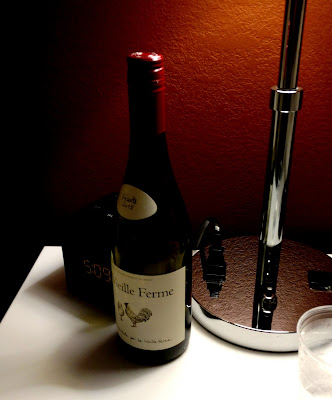Packing for a road trip is my most hated job. Perhaps a list will help me stay more organized.
To me, a successful job of packing means I come home with one clean pair of panties. I’d rather waste space on painting tools and supplies than on my personal gear. My last trip, however, ran a little longer than I’d expected. Washing clothes on the road was no big deal, but I didn’t have sufficient meds. It was a lesson that one can, in fact, cut it too fine.
I leave for Nova Scotia tomorrow. The forecast is for temperatures ranging from 9° to 24° C, which is 50°-75° in real money. That means double packing, because I must must be prepared for any weather.
Packing is my least-loved part of my job. I’ve decided to make a list, in the hope that it makes me a little more efficient. This is in addition to my list of painting supplies, which you can find here for oils, for watercolor, and for acrylics.
Feel free to comment with additional suggestions.
 |
| Rain happens, especially in the Northeast. In a plein air event, that’s no excuse for not getting your painting done. |
One week of clothing for the traveling artist
Clothing:
Fleece or cotton hoodie
Fleece or wool sweater
Cardigan or shawl for evening
Hiking boots
Hiking socks
Totally paint-spattered shirts—number of days +1
Totally paint-spattered capris—number of days divided by 2
One pair of long pants
Painting hat
Underpants—number of days +2
Bras—2
My bathing suit—not that I ever use it, but I can dream
A swim towel—ditto
Sandals
Raingear—a jacket AND waterproof pants
Sleepwear
One moderately dressy outfit for casual events
One actual dress or skirt for reception
Jewelry
Fleece or wool sweater
Cardigan or shawl for evening
Hiking boots
Hiking socks
Totally paint-spattered shirts—number of days +1
Totally paint-spattered capris—number of days divided by 2
One pair of long pants
Painting hat
Underpants—number of days +2
Bras—2
My bathing suit—not that I ever use it, but I can dream
A swim towel—ditto
Sandals
Raingear—a jacket AND waterproof pants
Sleepwear
One moderately dressy outfit for casual events
One actual dress or skirt for reception
Jewelry
 |
| Nobody does the painting hat quite as elegantly as Marjean Coghill. |
Grooming:
Cosmetics—especially for you guys. You look downright unkempt at times
Sunglasses, glasses cleaner and cleaning cloth
Sunscreen
Insect repellent
SPF lip balm
Aloe vera lotion for when you forget the sunscreen
Deodorant
Hairbrush and/or comb
Hair ties and bobby pins
Nail clipper
Razor
Shampoo and conditioner
Body wash
Prescription medications and vitamins. I sort mine prior to leaving into daily med containers
Toothbrush—I can get five weeks out of my electric toothbrush without a charge. I’ve tested this.
Toothpaste
Floss
Monthly feminine supplies
(You’ll need a clear plastic bag if you’re flying for some of these things)
Sunglasses, glasses cleaner and cleaning cloth
Sunscreen
Insect repellent
SPF lip balm
Aloe vera lotion for when you forget the sunscreen
Deodorant
Hairbrush and/or comb
Hair ties and bobby pins
Nail clipper
Razor
Shampoo and conditioner
Body wash
Prescription medications and vitamins. I sort mine prior to leaving into daily med containers
Toothbrush—I can get five weeks out of my electric toothbrush without a charge. I’ve tested this.
Toothpaste
Floss
Monthly feminine supplies
(You’ll need a clear plastic bag if you’re flying for some of these things)
 |
| Downloaded media will be your best friend when you’re stuck on the road back of beyond. |
First aid:
A small first aid kit in your trunk
Over-the-counter allergy meds
Aspirin and/or your favorite NSAID
Over-the-counter allergy meds
Aspirin and/or your favorite NSAID
Odd equipment for when I am traveling overland and have space to burn:
Bandana—I can soak this in water and stay cool on a hot day.
Porta-potty
Foldable wagon
Headlamp for nighttime painting
Small secateur clipper
Extra plastic poncho to cover easel in case of monsoon
Folding chair
Water bottle and a larger jug to refill
Nutritional bars and trail mix—no chocolate, unless you like cleaning up melted food
Brush soap
Baby wipes
Porta-potty
Foldable wagon
Headlamp for nighttime painting
Small secateur clipper
Extra plastic poncho to cover easel in case of monsoon
Folding chair
Water bottle and a larger jug to refill
Nutritional bars and trail mix—no chocolate, unless you like cleaning up melted food
Brush soap
Baby wipes
Electronics
Camera and charger
Cell phone and charger
Laptop and charger, if applicable
GPS if applicable
Fitbit charger
Spare charged external battery—this is a lifesaver when traveling
Cell phone and charger
Laptop and charger, if applicable
GPS if applicable
Fitbit charger
Spare charged external battery—this is a lifesaver when traveling
Headphones
Lastly…
Cash
Credit cards
Remember to turn on foreign cell service, if necessary
Download any media to phone or Kindle before leaving your wifi behind.
Credit cards
Remember to turn on foreign cell service, if necessary
Download any media to phone or Kindle before leaving your wifi behind.










